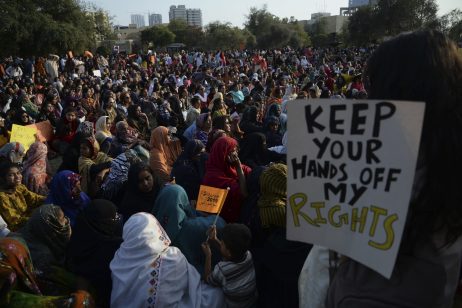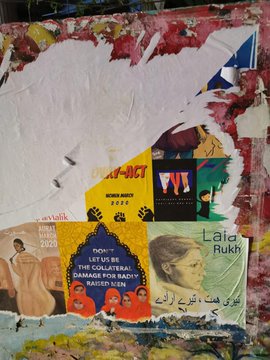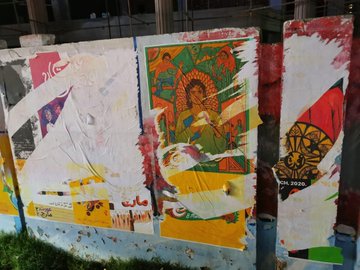Since 2018, the march has attracted fierce criticism, especially online. But the organizers and participants are undaunted.
On International Women’s Day, while women around the world celebrate freedom, independence, and womanhood, Pakistani women will come out of their houses to demand their right to march. Over the past two years, the Aurat [women] march has turned into a massive resistance movement against the patriarchal structures of society, resulting in a strong backlash against the participants and organizers of the march.
The Aurat March is organized under the banner of “Hum Auratain” (we women), an umbrella term for a collective of feminist women, transgender individuals, nonbinary persons, and gender and sexual minorities who stand against the patriarchal structures that result in the sexual, economic, and structural exploitation of women.
It all started two years ago when a couple of feminist groups from Karachi decided to hold a march on International Women’s Day, March 8.
The core principles of Hum Auratain dictate that the march could not be funded by NGOs or corporations. Instead, the organizers arrange fundraising events to collect funds. The marches, designed to be anonymous and diverse, are held in all major cities of Pakistan, including Lahore, Islamabad, Karachi, Peshawar, and Quetta.
Each year, the organizers release an Aurat March manifesto that demands accountability and restorative justice against violence targeted at women at the workplace, at home, and in public spaces. It also pushes for economic justice, inclusion, and access to public spaces for all. The Aurat March gave new momentum to the feminist movement in Pakistan – but with that it put the organizers and participants at risk.
Last year, the march organizers complained that they received threats and were harassed online.
They were labelled as “bad women” and Western agents who want to damage the culture of Pakistan. Some men even threatened them with rape.
A video of a well-known Islamic cleric has circulated on social media over the past year. The cleric is visibly furious over a placard at the Aurat March reading “Mera jism meri marzi” (my body, my choice). He threatened women with rape, saying that if they claim the right to their bodies, men can also claim the right to rape women.
The Khyber Pakhtunkhwa provincial assembly unanimously passed a resolution condemning the Aurat March. The resolution was moved by a woman parliament, Rehana Ismail, who said that the demands made at the march about women empowerment were “un-Islamic and shameful.”
The backlash largely targets the placards women bring with them. At the first Aurat March, in 2018, a placard reading “Apna Khana Khud Garam Kar Lo” [heat up your own food], intended to highlight the imposed gender roles in society, was criticized in online platforms. A private television channel aired a drama television series with the same title to ridicule the placard and the idea behind it.
The placards at the second Aurat March showed the wittiness of women participants and their unapologetic attitude toward the backlash. This time, a placard read “Apna Moza Khud Dhond Lo” (find your sock yourself) was taken up by Twitter and became the most discussed placard of the 2019 march.
This year, organizers are seeing a strong reaction even before the march. A controversial drama series that ended in January has already started a debate on feminism and the Aurat March. The series, “Meray Paas Tum Ho” (I Have You), told the story of a woman who decides to leave her husband after she meets a wealthy man through a friend. Pakistani dramas often tell stories of men who cheat on their wives, but that is shown as their right or a mistake; this show encouraged viewers to side with the aggrieved husband. The drama gained popularity with each episode; its finale a was screened in cinemas across the country.
Yet at the same time, feminists took to social media to call out the show for its misogynist dialogue and plot. The controversy took another turn when the writer, Khalilur ur Rehman Qamar, began appearing on talk shows criticizing the Aurat March, feminism, and women rights activists for bringing a “Western agenda” into Pakistan.
In one interview, he said that “women should gang rape men if they want equality.” In another interview Qamar said that the Aurat March is a conspiracy of some 35 women who belong to a specific class.
Artist Shehzil Malik designed some posters for the Aurat March, which she herself pasted in different areas of Lahore. These posters pay homage to brown women and celebrate their womanhood. The organizers found the posters torn down in some areas of the city. The Aurat March Lahore chapter tweeted that this is the reason they march.
Today we were buoyed by the love and behanchara on display today, only for it to be torn down hours later.
For those who say why we march--this is why!!
First picture: Earlier today as we built our mural.
Subsequent pictures: Later today, after our mural was torn down.
141 people are talking about this
Makeup artist Leena Ghani is one of the main organizers of the Aurat March in Lahore. While talking about the preparations, she said the beauty of the march lies in its diversity. It involves women from a range of backgrounds who put their efforts toward making this event happen.
“The theme for this Aurat March is Khudmukhtari [autonomy] and violence, both sexual and economic, that women suffer because of patriarchy. We have planned some performances around these themes hoping those will send a clear message,” she explained.
Ghani says that it is participants’ right to express their anger and concern through their placards. She also said that they will not censor their voices, as whatever messages they bring on those placards tells the issues women face.
“It’s not easy to know what kind of backlash to expect. However like last year we are going to remain open to discussion,” she said. “We will never be apologetic because we don’t believe in silencing peoples voices.”
The march’s critics often claim that women in Pakistan enjoy the utmost rights. They reject all negative reports on poor gender equality in the country, calling them propaganda against Pakistan.
The World Economic Forum ranked Pakistan as third worst in its 2020 Global Gender Gap report, which gauges economic opportunity, education, health, and political empowerment. The report also highlights that Pakistan is the worst of all the countries in South Asia. The region’s highest scorer was Bangladesh, which separated from Pakistan in 1971. Bangladesh ranked 50th, Pakistan 151st.
Ghani sees the backlash as a testimony of the success of the Aurat March. She says the response has made the marchers stronger.
“We had support from senior feminists who have experienced such backlash during their struggle for women’s rights in Pakistan. In all honestly, the backlash made us all so much stronger and united.”
Tehreem Hassan is a designer and visual artist based in Islamabad. Last year, she was one of the marchers but this year she is volunteering in the communications department of the Aurat March, Islamabad organizing team. She says the Aurat March is a collective struggle to raise voices against patriarchal structures that limit gender equality.
“This is not struggle of an individual,” she said. “It is a collective struggle that has the power to turn into a mass movement all across Pakistan.”
Critics of the Aurat March often say that it does not highlight real issues of Pakistani women. Talking on the subject, Hassan said that every issue is a real issue.
“We believe that every issue is a real issue, whether it is about mobility, body, autonomy, or gender roles. So many women are harassed, raped, beaten, and forced into prostitution. That’s why we say ‘Mera Jism, Meri Marzi’ [my body, my choice]. Do they have an issue with it?”
She also said that this movement does not belong to any specific group or class.
Ghani said those who think the Aurat March does not highlight the real issues of Pakistani women have probably missed out on the event. She invites them to attend this year’s march.
“I would like to extend an invitation to them so they can come see for themselves that the Aurat March platform is for those who have been forgotten, by this state and this country — the voiceless and the helpless. And that is something one doesn’t see in the media or online.”






No comments:
Post a Comment